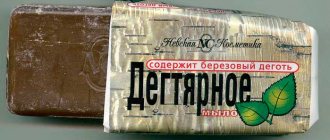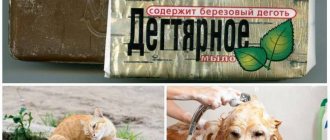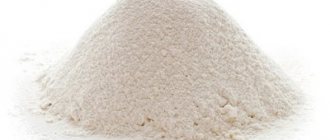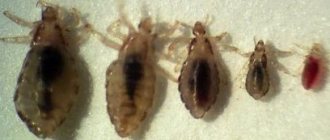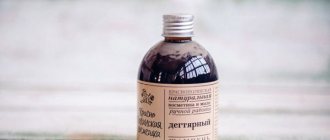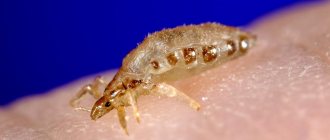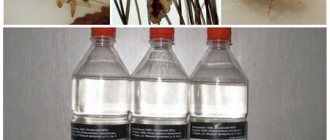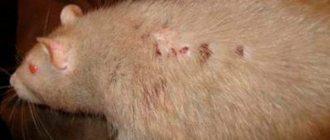Pediculosis is a disease of parasitic origin, which is characterized by damage to the scalp and hair by lice. It is accompanied by severe itching at the bite sites and requires immediate treatment. Dust soap for lice and nits has established itself as an effective and inexpensive remedy, used since the last century.
Dust soap is a laundry soap that contains the powerful insecticide DDT.
Properties and features of dust soap against lice and nits
Externally, this soap is not much different from laundry soap, but its main component is dichlorodiphenyltrichloromethylmethane (DDT), a toxic substance used in the fight against lice, fleas, ticks, cockroaches, agricultural pests and other insects. The content of this component in the bar is only 5%. This amount is enough to destroy parasites and not cause harm to humans. People call DDT dust, which is where the name of the soap comes from.
In addition to dichlorodiphenyltrichloromethylmethane, soap contains alkalis, phenol derivatives and fats of plant or animal origin. Depending on the production method, the content of the latter in the bar can be 65, 70 or 72%.
Soap with dust has a specific unpleasant odor, so its use can only be done in a well-ventilated area or outdoors.
Precautionary measures
Since dust soap contains a toxic substance, it is necessary to work with it in a well-ventilated area. Access to fresh air must be provided for several hours so that the “aroma” completely disappears. You should not process it yourself. To ensure that if signs of poison occur, first aid is provided immediately, use the help of third parties.
A person working with dust soap needs to use protective equipment: rubber gloves, a respirator. It is also better to cover your eyes with special glasses. Soap foam that gets on exposed areas of the body is washed off with a stream of water as quickly as possible.
The respiratory tract of the person being treated also needs to be protected. To prevent accidental contact of soap with the cornea, the eyes should be closed tightly. The neck and shoulders are protected with fabric that absorbs liquid well.
Important point! A single external use of the product is not dangerous for people and animals if the rules are strictly followed.
If disinsection is carried out on an animal, care must be taken to ensure that the substance does not enter the pet’s esophagus. For this, a protective collar is used that will prevent the dog or cat from licking the fur treated with poison. Veterinarians warn that it is necessary to use the product to treat pets once, taking all precautions. The insecticide is contraindicated for animals that are not yet 10 months old. The drug is not used for tick bites, in which case there is an open wound and the poison will enter the blood. And it will be difficult to remove a dead parasite.
Operating principle
When dust soap is applied to foci of head lice, dichlorophenyltrichloromethylmethane penetrates deeply through the chitinous cover of lice, causing their death. In addition to killing adults, DDT has a detrimental effect on the larvae, destroying their protective cocoon and destroying the glue with which they are attached to the skin and hair.
When soap is applied, lice die.
What is a body louse?
Body lice are parasites that live in human clothing and feed on blood. These are close relatives of head lice that do not live permanently in public, set up homes and breed in seams and folds of clothing. Along with head and pubic lice, body lice suck blood and spread dangerous infections. All types of lice can be present on one person at the same time.
Appearance
The body lice are the largest of the lice. The body size is 2-5 millimeters, there are no wings, the cover is translucent. The body darkens after being bitten and filled with blood. The head is narrower than the body, there are antennae - an organ of touch and smell.
general characteristics
Most of the time, body lice hide in clothes and come out on the body 5-6 times a day to feed. They live in colonies. They survive at temperatures of 0-40°, preferring a comfortable 30-32°. When the owner dies or the body temperature rises sharply due to heat and illness, they leave. If clothes are not worn for more than a week, they die of hunger.
Life cycle
The life cycle of a louse (from egg to egg) lasts from 16 days. During her life, the female produces up to 3 hundred eggs, laying 8-10 eggs daily. The female lays eggs in clothes, gluing them with a special mixture. The eggs (nits) remain in this state for about a week, then the young hatch and reach maturity in 8-10 days, spreading through clothing. Life expectancy is a little more than a month.
Nutrition
To feed, the louse comes out of the clothing and onto the body. The cone-shaped mouth is located at the front of the head and is equipped with teeth that, like anchors, help secure it when biting. The proboscis with needles rests on the body, the needles pierce the skin and gradually go deeper, looking for a vessel. Contraction of the lice's pharynx muscles ensures sucking (up to 0.003 milliliters of blood at a time). The enzyme released keeps the blood from clotting.
Types of bites
At the site of the louse bite, a pink-red swelling (papule) with dried blood in the middle forms. The intensity of the color and the size of the swelling depend on the characteristics of the body and the presence of an allergic component. The body of a person suffering from lice gradually becomes covered with a dense network of such spots, as lice feed frequently and the population grows rapidly.
Instructions for use
To remove lice, dust soap must be used according to the following scheme:
- Grind the bar and, diluting with a small amount of water, beat until foam forms.
- Distribute the foam mass over the scalp and hair, making sure that the surface to be treated is evenly covered. If any area is not soaped, the parasites on it will not die, and the expected effect will not occur.
- Cover your head with a plastic bag or a cosmetic hair cap, then wrap it with a terry towel.
- At the end of the procedure, wash your hair 3-4 times with shampoo under warm running water. Repeated washing is necessary to get rid of the unpleasant odor.
- Treat your hair with a conditioner with a moisturizing and soothing effect. It will prevent them from drying out and speed up the healing of wounds formed at the bite sites.
- Dry your hair, then carefully comb out the dead parasites with a fine-toothed comb.
Where to buy dust soap?
Since dust soap is one of the drugs that are highly toxic, it is quite difficult to buy it. Its sale is prohibited in hardware stores. If you need to purchase dust soap, it is recommended to look for it on the pages of specialized online stores. Contact companies that deal with antiparasitic drugs.
Where can I buy? The sale of soap soap is prohibited in hardware stores, because soap is quite toxic. Search online stores and disinfection services.
It is also possible that you can find it by rummaging through the old stocks of your friends and relatives. Indeed, in Soviet times, many stocked up on this product. Only a few decades ago it was impossible to imagine that there were not several pieces of dust soap stored in the house. Many grandmothers put it in chests for storage. Surely many people still have such savings left.
In addition to efficiency, there was another reason why almost every person used dust soap. We are talking about low cost. In Soviet times, consumers paid special attention not to safety, but to the price of a substance. Today the cost of dust soap is also cheap. To buy one piece you will need 30-50 rubles. Therefore, many “the old fashioned way” prefer to use this particular remedy.
How to use this tool:
- Wet your hair and create a small layer of foam from dust soap on it;
- Put on a hat with an elastic band around the edges;
- Wrap a towel on top;
- Keep the product like this for 30 minutes;
- Rinse off the foam with running water, then wash your hair with regular shampoo at least two times in a row;
- Apply a soothing balm;
- Dry your curls thoroughly;
- Comb your hair with a special comb. This will remove dead parasites that were not washed away by water;
- After washing your hair, sit for some time in a room with good ventilation;
- To reduce the level of intoxication, you can drink a glass of milk.
Pets are often treated with dust. To get rid of fleas, just leave the fur soapy for 5-10 minutes. After this, rinse off the foam. The pet must be bathed using a special collar that will not allow the animal to lick its fur.
How long to leave on hair
To destroy parasites, it is recommended not to rinse the soap off your head for 30 minutes. You cannot leave it on your hair longer, since prolonged exposure to the dust can cause poisoning in a person.
To kill lice, soap should not be washed off for 30 minutes.
If burning, severe itching or other unpleasant sensations occur during the procedure, the soap should be washed off earlier.
Algorithm for using soap
The dust treatment process is carried out as follows:
- the soap is applied to wet hair and foams thoroughly;
- the head is covered with a plastic bag, wrapped in a towel or a knitted cap is put on;
- After about 15 minutes, the soap is washed off, the hair is washed several more times with shampoo;
- wet hair is treated with balm;
- dried hair is carefully combed with a thick comb, strand by strand. The comb will remove any remaining nits.
Advantages and disadvantages
Dust soap was widely used in the fight against head lice in the 1960s and 70s, but today it is still used for this purpose, although not as actively. It gained popularity among the people due to its advantages, which include:
- High efficiency. Manufacturers who produce antiparasitic shampoos recommend using them several times to get rid of head lice. DDT solves the problem after the first application.
- Low price. Soap is much cheaper than anti-lice and nit shampoos sold in pharmacies.
Dust soap is highly effective and low price.
Despite its advantages, some people refuse to use this product because of:
- toxicity;
- strong unpleasant odor;
- negative impact on hair (it becomes brittle and dull).
Composition and action
The composition of the soap is simple: ordinary laundry soap is responsible for the cleaning effect, and the insecticide DDT provides insect control.
The principle of its operation is that it penetrates the bodies of insects through their integument and causes instant poisoning. Lice dust soap affects the insect's nervous system , thereby killing it.
Interestingly, thousandths of a gram of the substance are enough to kill one adult fly. Moreover, the drug kills not only lice, but also nits without the need for any additional impact on them.
Read more about the types of lice, how they reproduce, and the incubation period on our website.
Not every modern product has such a strong effect, and high destructive power is definitely one of the most important advantages of dust soap. It also has a very pungent odor that will take at least a few hours to dissipate.
ON A NOTE! In appearance (and also in its smell), dust soap is very similar to tar soap, however, these are completely different products. Tar soap is mostly a cosmetic product, while dust soap is a medical product.
Precautions for use
To avoid adverse health effects after using soap with dust, it is important to follow the following safety rules:
- It is not advisable to soap your hair yourself. If possible, you should ask someone close to you to do this.
- It is recommended to use the product with rubber gloves. At the end of the procedure, they are disposed of, pre-wrapped in a plastic bag.
- Do not allow foam to come into contact with the skin of your hands or other parts of the body (except the head). If this cannot be avoided, the soap should be immediately removed from the skin with plenty of running water.
- To prevent your health from worsening due to the strong smell of DDT, the head is treated near an open window or on the balcony.
- Soap should not be allowed near food, water or medications.
- There should be no strangers in the room where the procedure is carried out, except for the person performing the soaping and animals.
- During the procedure, a person must keep his mouth and eyes closed to avoid toxic substances entering the mucous membranes and digestive tract. You can use a respirator and safety glasses for this purpose.
Soap should not be stored near food or medications.
If the decision is made: how to properly use dust soap
But if you still decide to use dust soap against lice (highly not recommended), it must be used in accordance with the following rules:
- the handler must put on a respirator, goggles and rubber gloves, wet the soap and lather the patient’s hair
- the patient must sit with his eyes and mouth closed at all times
- After applying the soap, put a rubber cap or bag on your head, which is tied under the hairline with an elastic band.
- the foam is kept on the head for up to half an hour (at the first sensation of tingling, burning, itching, it needs to be washed off) and the head is thoroughly washed with simple shampoo several times
- While the hair is still damp, it is combed with a fine comb (it is good to use special pediculicidal combs for this) to remove dead lice and nits.
It is worth remembering about the very unpleasant smell of dust: after removing lice, its “aroma” can persist for quite a long time.
Dust soap should not be used frequently or regularly. The dust destroys lice and nits already during the first treatment, but if suddenly after this the parasites still remain on the head, it is better to remove them by any other means.
Contraindications for use
Doctors prohibit fighting lice with this soap in the following cases:
- pregnancy or breastfeeding;
- weakened immune system;
- chronic diseases of the respiratory system;
- tendency to allergic reactions;
- increased body temperature;
- the presence of wounds and ulcers on the scalp, through which a toxic substance can penetrate into the blood;
- increased dryness of the scalp.
In addition, do not reuse soap if it has been used within the last 2 weeks.
Efficiency in the treatment of pediculosis
Dust is an insecticidal agent with a contact effect. If you do not pay attention to the danger, then this is one of the most effective means of eliminating lice and nits. DDT has the properties of quickly entering the body of a blood-sucking insect through the chitinous shell.
Thanks to strong soaping of the hair, you can achieve instant destruction of parasites. One of the positive qualities of this method is the ability to destroy the strong shell of lice, as a result of which they die in a short time.
Expert opinion
Sidorenko Veronika Leonidovna
Modern products contain dust in concentrations that are harmful to parasites, but safe for humans.
Thanks to the latest developments in the chemical and pharmaceutical industries, you can find any effective medicine for head lice. Pharmacies sell various shampoos that can eliminate lice after the first use. They do not poison the body and can be used to treat children.
Side effects and contraindications
If you decide to remove lice with dust, you need to familiarize yourself with the contraindications that exist for the use of dust soap. You need to know what harm it can cause and the concentrations that cause poisoning in humans.
In the mid-twentieth century, dust was used very widely. Its impactful and extremely effective effect on insects caused euphoria. The drug was sprayed over the fields even with the help of airplanes, without any concern for safety measures.
Sobering up came in the 60s of the twentieth century, after cases of dust poisoning, some of which were fatal. Detailed studies showed a terrible feature of the insecticide: it accumulated in the human body and was not removed from there.
Considering that dust cannot be decomposed by water, sunlight, elevated temperatures, and the uncontrolled use of insecticide, it is difficult to say where and when a person accumulated so much toxic substance in the body that its presence caused poisoning.
In addition to the cumulative effect, the dust has the following properties:
- lowers immunity;
- provokes mutations;
- disrupts brain function;
- promotes the appearance of cancerous tumors;
- may cause fetal death or serious disturbances in its development in pregnant women.
This forced the governments of most countries to ban the use of dust.
Still, caution must be exercised when using it, especially since there are side effects:
- allergic reactions, including skin rashes;
- muscle weakness;
- attacks of suffocation;
- dizziness and headache;
- nausea and possibly vomiting.
If any of these symptoms occur, you should visit your doctor. There are also strict contraindications for use:
- pregnancy and breastfeeding;
- childhood and adolescence;
- illness or weakening of the body, dust soap is especially dangerous for asthmatics; damage to the skin.
For those listed on the list, it is better not to take risks and choose a pediculocide that does not have such strict contraindications.
Conclusion
Knowing all the contraindications for use and possible side effects, each person must decide whether to use dust soap for lice and nits or choose another less harmless, but also less effective remedy.
Side effects from soap
A common side effect after using the product is increased dryness of the scalp. To restore the condition of the skin, it is necessary to provide enhanced care to the hair: wash it with shampoo with a moisturizing effect, treat it with conditioner, make masks, etc.
A side effect is dry scalp.
If safety precautions are violated, a person may experience symptoms of intoxication. They appear as:
- headache;
- dizziness;
- nausea;
- vomiting;
- loss of consciousness;
- muscle spasms;
- respiratory dysfunction.
Gastric lavage and taking sorbents during dust intoxication will not bring any effect, therefore, if the described symptoms appear, the patient must be urgently hospitalized.
With frequent use, DDT accumulates in the body and is almost not removed from it. Because of this, people who repeatedly use it experience disturbances in brain function, decreased immunity, and mutagenesis (changes in DNA structure). A side effect can also be the development of a malignant tumor.
Contraindications and side effects
Contraindications for using dust soap are:
- breastfeeding period and pregnancy;
- various diseases of the nervous system;
- a person's predisposition to allergies;
- weak immunity;
- skin diseases;
- irritated or dry scalp.
If there is an excess amount of DDT, the following consequences are possible:
- weakening of the body's protective functions;
- formation and growth of cancer cells;
- mutations;
- disturbances in brain function;
- serious disturbances in the development of the fetus in the womb.
Poisoning will be indicated by headache, nausea, upset stomach, dizziness, difficulty breathing, muscle spasms and various skin rashes. If at least one of the listed symptoms occurs, you should seek medical help as soon as possible.
Characteristics and useful properties
In its composition, dust is practically no different from ordinary laundry soap. The only difference is that it contains DDT - dichlorodiphenyltrichloromethylmethane, a very toxic substance. It can penetrate under the chitinous cover that protects insects, thereby causing their death. DDT has a very unpleasant odor that is difficult to get rid of.
DDT became widespread. With the help of this substance, insect pests were destroyed in fields and gardens for many years. In some cases, it was used even when there was no good reason for it.
This toxic substance has saved the lives of more than 10 million people. A malaria epidemic began in India. If it were not for the timely use of DDT, the consequences would have been dire. All nearby bodies of water were treated with the substance.
Particular attention was paid to areas where malaria mosquitoes, which are carriers of the disease, accumulated and multiplied. Similar situations were repeated in Greece and Italy.
Dust soap became the most popular when they learned about its ability to destroy lice and nits. It has one peculiarity: not only adults, but also larvae die after a single treatment.
Anti-lice products
When choosing a remedy against lice and nits, you need to be guided by the age of the patient, the degree of allergy, the presence of skin diseases and other considerations. The range of products is currently very wide. This can be an anti-lice shampoo containing a chemical insecticide or other substances, liquid permethrin, Nuda, cherry water and tar soap. In the last century, kerosene, sulfur ointment, onion-egg mixture, anise oil, cranberry juice in combination with a fine comb were used for this.
People who do not want to use chemical compounds in the fight against lice often prefer natural compounds, for example, inexpensive and accessible tar soap. The birch tar included in its composition is extracted from the bark. You should not use it in its pure form, as it can cause skin burns. Solid and liquid soap contains about 10-15% tar. This substance has a strong antifungal, antiseptic, wound healing and soothing effect. Tar-based products are often used to treat skin diseases, in particular acne, dandruff, various eczemas, lichen, psoriasis, etc. In extremely rare cases, tar soap causes an allergic reaction. However, it is better to do a skin test for allergies. To do this, you need to soap the area of skin on the inside of your arm and wait 15-20 minutes. If there is no redness, then everything is fine. Pregnant women are not advised to remove lice with tar soap due to the long time of contact of its compounds with the skin.
The inhibitory effect of tar on lice is based on the increased content of phenols, their derivatives and alkalis. True, these substances do not have a noticeable effect on nits. Initially, tar soap was used to combat fungal skin infections and irritation caused by bacteria and viruses; later it was discovered that the soap helps against lice.
Lice dust
As mentioned above, dust, essentially, due to objective reasons, became illegal. Nevertheless, this drug is very effective in the fight against lice.
Where to buy dust soap
DDT - this drug has contact properties. It is able to penetrate the insect’s body through the chitinous cover of the body. In other words, with one treatment you can destroy the louse and its nits, every single one.
The concentration in the soap is calculated in a sufficient amount so that there is no concern about the amount applied to the scalp.
Despite medical prohibitions and protests, there are those who prefer dust soap to other modern drugs. Therefore, a considerable number of people are interested in the question: where can I buy it?
You can purchase this product in stores or on websites that specialize in selling antiparasitic products. The price will vary from 5 to 10 UAH per 65 g (1 piece).
Defeat lice
It is important to follow the rules of use
If you still decide to wash your hair with dust soap to solve the problem, then follow these recommendations:
- the handler must wear a respirator, rubber gloves and goggles;
- the patient with lice must close his eyes and mouth during the procedure;
- After applying the product to your head, put on a rubber cap;
- leave the foam on the hair for about 30 minutes, if there are no unpleasant sensations;
- After the time has passed, rinse your hair thoroughly several times with any shampoo;
- Comb wet strands with a thick comb to remove dead parasites and nits;
- Do not use this soap frequently; if necessary, repeat the procedure using another product.
Precautionary measures
Scientists believe that the accumulation of DDT in the body leads to various types of mutagenic disorders, the development of malignant tumors, the occurrence of diseases of the nervous system, weakens the immune system, and causes fetal death in pregnant women. Although there is no direct evidence of this, the premises that these assumptions are valid are significant.
Signs of poisoning
The following signs will help you understand that poisoning has occurred:
- feeling of nausea, bouts of vomiting;
- weakness and feeling of aching muscles;
- attacks of headache and dizziness;
- the appearance of shortness of breath, and in patients with asthma - exacerbation;
- allergic rashes.
In case of contact with skin, the insecticide does not cause any particular harm.
But during the lice removal procedure, the product may get into the eyes and nasal mucosa, which will result in the substance entering the body.
Actions in case of poisoning
If at least one of the listed symptoms appears, the victim should be immediately shown to a doctor.
Procedures for gastric lavage and the use of activated carbon in this case will be ineffective.
Contraindications
The following contraindications exist:
- pregnancy;
- asthma;
- dry scalp.
Dust soap against lice how to use
Removing lice and nits with dust soap is very simple. Just lather your hair with it and leave it under the film for 30 minutes. Rinse off.
Complete recovery from head lice is guaranteed. No modern insecticidal agent has this effect, because it is powerless against nits.
Dust soap against lice for pregnant women
The use of dust soap for pregnant women is strictly prohibited due to its high toxicity. This can significantly affect pregnancy and the development of the baby in the womb. Many other folk remedies are also prohibited.
Simple mechanical combing can help pregnant women. To do this, you need to use a special comb with fine teeth. It is better to carry out the procedure in the bathroom, or in the room, covering your shoulders with something light. This will help catch lice. It is almost impossible to remove nits without special hair treatment. The fact is that insect eggs are secured with a special adhesive liquid and they stick tightly to the hair. For pregnant women, it will be safe to use a tincture of anise oil with alcohol. This composition is included in some pharmaceutical products. Afterwards, comb your hair.
For expectant mothers who are not afraid to dye their hair with chemical dye, coloring their hair with dye based on hydrogen peroxide will help. Peroxide kills not only insects, but also their nits. We need someone to help with coloring. The dye should be applied close to the root, but avoiding the scalp. There may be a nit in the missing area near the root.
Therefore, it is important to apply the paint efficiently and thoroughly. Afterwards, mandatory combing
A good and effective method for pregnant women to remove hair parasites is to use a hair straightening iron. Adults need to be combed with a comb. Under the influence of the temperature of the iron (above + 30C), the nits burst.
Soap composition and its effect on hair and scalp
Since the 90s of the twentieth century, laundry soap has been produced in three varieties according to GOST:
- 72% – first category;
- 69% – second category;
- 64% – third grade.
The composition of soap differs only in the percentage of elements, primarily fatty acids.
Fatty acid
These elements are of plant and animal origin and affect the elasticity of hair and skin. With constant use, they eliminate hair loss, split ends, and make the scalp more elastic. When used for antiparasitic purposes, they help restore hair and scalp faster. The following liquid crystals are used in laundry soap:
- palmitic – promotes cell renewal, activates the synthesis of hyaluronic acid, collagen and elastin;
- lauric – has an antimicrobial effect, reduces skin inflammation, promotes gluing of split hair ends.
Kaolin
Kaolin or white porcelain clay is an essential element in laundry soap. It softens the effects of alkalis on the skin.
Important: if kaolin is not present in the soap, then it cannot be used to wash your hair.
Sodium
The most important element that regulates water balance in metabolic processes. It is necessary both to maintain hair moisture and to dilate blood vessels in the scalp. Prevents hair loss and fragility.
Animal fats
This is an integral component of any hair and skin cleanser, which nourishes it, fills it with keratin and provides elasticity.
Sometimes natural fats are replaced with synthetic ones, this only leads to a decrease in the characteristic odor, but not to a decrease in the quality of the product.
Water
Fresh purified water is the basis of any detergents. The process of making soap is impossible without H2O, since all of the above substances are water-soluble, and in water they mix, interact and transform into a homogeneous mass.
